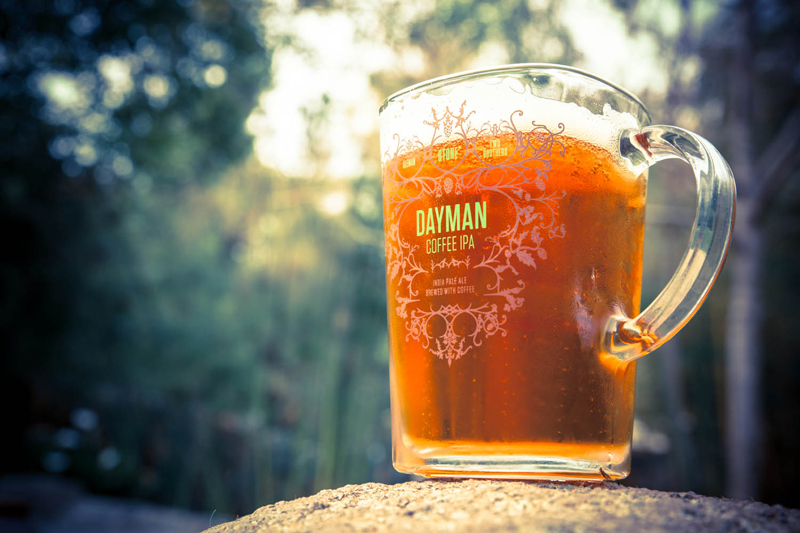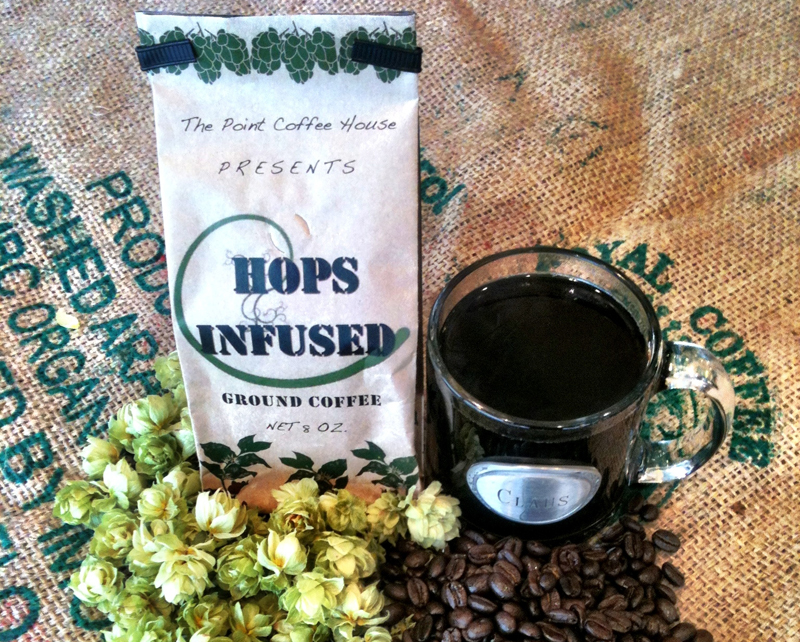Roast Masters: Exploring the Art of Brewing Beer with Coffee
The Other Way Around
If brewers are putting coffee in beer, why can’t roasters put beer in their coffee? Well, they can. Given the popularity of coffee flavored with everything from pumpkin spice to vanilla and nuts, it was only a matter of time before roasters began to impart flavors of beer into their beans. One such roaster is the Point Coffee House in Rehoboth Beach, DE, where Sean Hixon worked with Delaware-based brewery 16 Mile to create a beer-infused coffee.
“The idea is part of our food series of ‘taking beer outside the bottle,’ ” says 16 Mile’s sales and marketing director, Claus Hagelman. “This has created gourmet cheeses, breads, ice creams, snacks, to now coffee with local small family-owned artisan companies.”
The two companies worked together to create the idea of what they wanted. “Then we stepped back and let Sean figure out how it could be done in coffee.” Hixon created a way to age coffee beans in hops. “Then the two worlds are blended together and ground, so you get a smooth malty coffee that has a hop nose,” Hagelman says.
The coffee series is called “Hops Infused.” And Hixon is also working on a very limited-edition batch, aging the beans for a year, to be released annually.
Hixon is quick to remind that historically in America, coffee was blended with chicory or malt since coffee itself was so rare and expensive.
“We are also paying tribute to history,” says Hagelman, “which is something we love to do here at the brewery.”

In 2013, Stone Brewing Co., Aleman Brewing and Two Brothers Brewing collaboraed on DayMan Coffee IPA.
Beyond the Dark
Because of the similarities, most breweries—if they make a coffee beer—tend to use a porter or stout for a base. Occasionally, a brown ale, like the one from Surly, or the strong ale used in Boulevard’s Brewing Coffee Ale, make it into the mix.
However, there are some, like Carton Brewing, that go the different route. Same for Stone Brewing Co., which released DayMan Coffee IPA, a collaboration with Aleman Brewing of Chicago and Two Brothers Brewing Co. of Warrenville, IL, in mid-2013.
Calling it an intriguing beer, Stone brewer Jeremy Moynier says the IPA offers a totally different canvas from a stout, and by using Citra hops, lemony notes in the coffee both “melded together and really brought out the best of both. The coffee was bright and punchy.”
Searches of beer databases come up short on too many other examples of where coffee beers veer off the darkened path. However, it’s a good bet that, given the continuing pushing of the brewing envelope, coffee will soon find its way into all manners of styles, meaning drinkers will no longer have to decide between a mug of coffee or a glass of beer, because both will be available in the same cup.
This story appears in the May issue of All About Beer Magazine. Click here for a free trial.
John Holl
John is the editor of All About Beer Magazine and the author of three books, including The American Craft Beer Cookbook. Find him on Twitter @John_Holl.


Anyway Augie could give the average home brewer the complete recipe to attempt to make a clone of this? We hate waiting once a year for this to come out.
Hi Robert, we’ve reached out to the brewery to see if they’ll release the recipe. Stay tuned.
I left a comment yesterday regarding how much liquid you’d want to use – looks like 16ozs for a 5-gallon batch. Does that sound right?
I have an Irish Stout I’ll be brewing soon & want to add some coffee flavor – can you ballpark how much coffee I’d need for a 5-gallon batch?
“Using a half gallon of doubled-brewed coffee for every 20 gallons of beer…” equates to ~16ozs of liquid, which doesn’t sound like enough…
for a 5-gallon batch, I cold brew the coffee and add 1-1/2 to 2-1/2 cups to the bottling bucket, on bottling day, according to which beer of mine I’m adding coffee to. Brown ales and porters require less, whereas Russian imperial and Foreign Extras require more, since they usually contain more black roasted malts anyhow. Hope that helps!
For what it’s worth, I think it’s awesome that you guys are helping each other out with this. It shows the camaraderie of the beer community and I dig it. Cheers!
I work at a nano brewery and came up with this “by the pint” method. Double cold brew coffee-10 scoops of grounds in a quart of water, 12-24 hours. Filter out grounds. Add about 3/4 to 1 ounce to a pint glass and pour a porter or stout. Works great with flavored coffee like Creme Brulee or chocolate raspberry. Also, add 3 chopped up habaneros to a pint of porter or stout in a glass bottle with a pour spout. Add a half to one ounce to a pint of beer, or more to taste. “By the glass” lets you experiment without making a whole batch or taking up an extra tap. I like chocolate raspberry coffee with habanero in a good porter!
I’m brewing a coffee porter and I plan to cold brew as described above. Should I boil the coffee to sterilize it before adding it to the bottling bucket?
I wouldn’t boil it. Sanitize your equipment that you will cold brew in, but I wouldn’t worry about sanitizing the beans. You are adding it to finished beer and its unlikely that a minor amount of anything on the beans would be able to add many off flavors
I’ve added coffee to a couple imperial stouts and have added 2 oz of hand crushed beans at flameout, then 2 oz of hand crushed during the secondary for about 1 week. The flameout coffee only added a minor hint of coffee flavor that is easily hidden in the layers of tbis chocolate stout. the secondary coffee imparted much more coffee flavor, but nothing too overpowering for this big of a beer. I’m planning on trying a cold toddy method rather than adding beans directly to the secondary on my next go around. Again, I used about 4 oz total of coffee beans for a 5 gal batch of a RIS.
Looking for some help…I want to add about 16 ozs of cold brewed coffee to my 5 gal Irish Stout. Is there any harm in adding it at the beginning of fermentation rather than before bottling? Seems like more time together with the brew would help meld flavors better? Any pros…cons to either?
Any help is appreciated!
The fermentation process will change the flavor. It’s probably subjective as to whether it’s for better or worse. Most recommendations are to wait until fermentation is complete, so either in a secondary or in the bottling bucket
I’m putting mine in a 5 gallon keg. So I would add the 16 ounces of cold coffee while I’m kegging it?